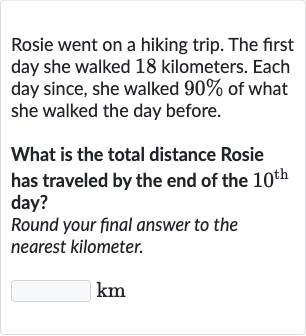AI tutor
Full solution
Q. Rosie went on a hiking trip. The first day she walked kilometers. Each day since, she walked of what she walked the day before.What is the total distance Rosie has traveled by the end of the day?Round your final answer to the nearest kilometer.
- Identify initial distance and decrease rate: Identify the initial distance walked and the daily decrease rate.Rosie walked kilometers on the first day. Each subsequent day, she walked of the distance she walked the day before. This means there is a daily decrease rate of ().
- Calculate distance on second day: Calculate the distance walked on the second day.To find the distance walked on the second day, multiply the first day's distance by %.Distance on second day =
- Recognize pattern of distance walked: Recognize the pattern of distance walked each day.The distance walked each day forms a geometric sequence where the first term is and the common ratio is ( of the previous day).
- Use formula for sum of geometric sequence: Use the formula for the sum of the first terms of a geometric sequence to calculate the total distance.The sum of the first terms of a geometric sequence is given by , where is the first term, is the common ratio, and is the number of terms.
- Calculate total distance on th day: Calculate the total distance walked by the end of the th day.Using the formula from Step , with km, , and :
- Perform calculations: Perform the calculations.First, calculate :Now, substitute this value into the formula:
- Round final answer: Round the final answer to the nearest kilometer. kilometers
More problems from Weighted averages: word problems
QuestionGet tutor help
QuestionGet tutor help
QuestionGet tutor help
QuestionGet tutor help
QuestionGet tutor help
QuestionGet tutor help
QuestionGet tutor help
QuestionGet tutor help
QuestionGet tutor help

